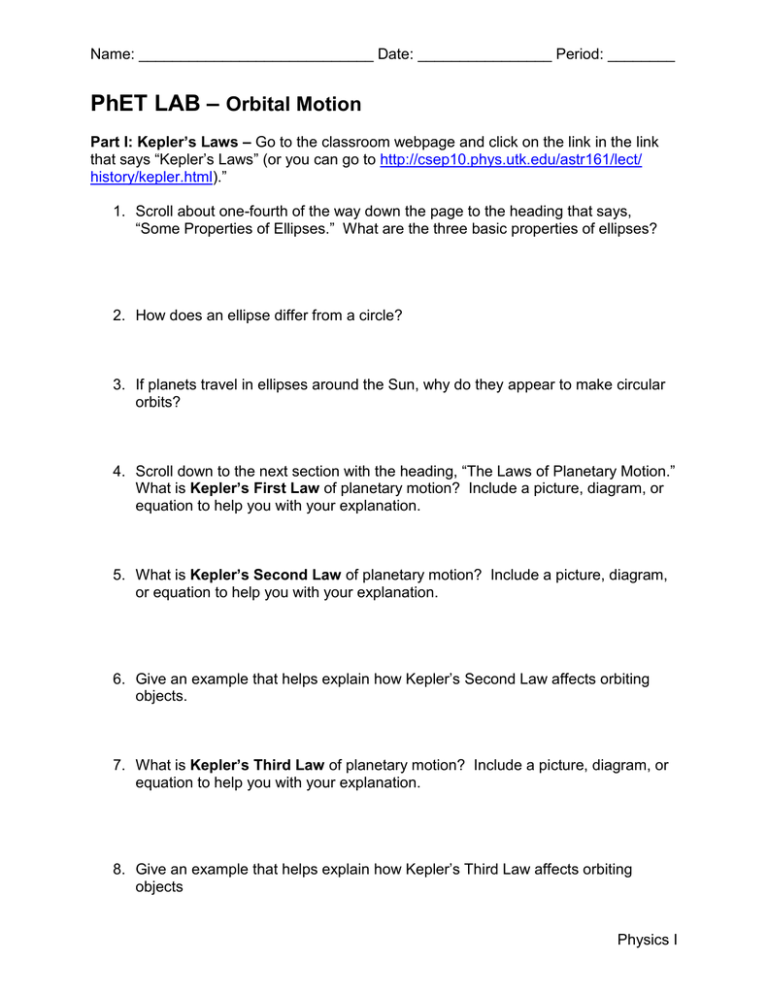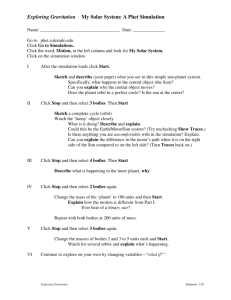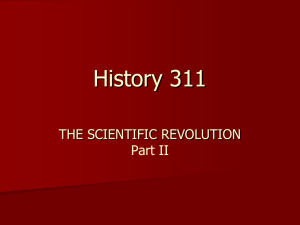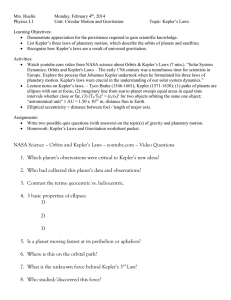Orbital Motion - Rohrbach Science
advertisement

Name: ____________________________ Date: ________________ Period: ________ PhET LAB – Orbital Motion Part I: Kepler’s Laws – Go to the classroom webpage and click on the link in the link that says “Kepler’s Laws” (or you can go to http://csep10.phys.utk.edu/astr161/lect/ history/kepler.html).” 1. Scroll about one-fourth of the way down the page to the heading that says, “Some Properties of Ellipses.” What are the three basic properties of ellipses? 2. How does an ellipse differ from a circle? 3. If planets travel in ellipses around the Sun, why do they appear to make circular orbits? 4. Scroll down to the next section with the heading, “The Laws of Planetary Motion.” What is Kepler’s First Law of planetary motion? Include a picture, diagram, or equation to help you with your explanation. 5. What is Kepler’s Second Law of planetary motion? Include a picture, diagram, or equation to help you with your explanation. 6. Give an example that helps explain how Kepler’s Second Law affects orbiting objects. 7. What is Kepler’s Third Law of planetary motion? Include a picture, diagram, or equation to help you with your explanation. 8. Give an example that helps explain how Kepler’s Third Law affects orbiting objects Physics I Name: ____________________________ Date: ________________ Period: ________ Part I: Build a Solar System – For this part of the lab, go to THE classroom website and click on the “My Solar System” link. Or go to http://phet.colorado.edu and type “My Solar System” in the search box. After the page loads click, “Run now.” 9. For the first demo you should have a simple sun-planet system. a. Click, “start,” and sketch and describe the motion below. b. What do you notice about the motion of the Sun? c. Why do you think it moves like this? d. Does the planet follow a circular or elliptical path (if it is a circular path, the sun should be in the exact middle of the orbit)? e. Explain your answer for part d. f. What do you notice about the velocity of the planet as it orbits the sun (when does it speed up, when does it slow down, or is it constant through its entire motion)? 10. Click “stop” and switch the number of bodies to 3 (bottom left corner). This should give you a sun-planet-moon system. a. Click “start” and again, sketch and describe the motion below. b. Unclick the checkmark that says “show traces.” Explain what the small object is doing. c. Which object (or objects) is the Moon orbiting (hint: this is kind of a trick question)? Explain!!! Physics I Name: ____________________________ Date: ________________ Period: ________ d. Turn “traces” back on. Explain why the moon’s path is different on the right side of the sun, than on the left. 11. Click “stop” and switch the number of bodies to 4 (bottom left corner). This should give you a system with a sun, two planets, and moon. a. Click “start” and again, sketch and describe the motion below. b. Why do you think the inner planet does not seem to orbit over the same path? 12. Click “stop” and switch the number of bodies once again to 2 (bottom left corner). Also, change the mass of object two to 100. a. Click “start” and again, sketch and describe the motion below. b. How is this different than the two object system in #1, and is this? c. What happens if you change the mass of both objects to 200? 13. Click “stop” and switch the number of bodies once again to 3 (bottom left corner). Also, change the mass for both objects two and three to 5. a. Click “start” and again, sketch and describe the motion below. b. How is this different from #2, and why is this? Physics I Name: ____________________________ Date: ________________ Period: ________ 14. In the upper right hand corner, where it says, “select preset,” click the drop down arrow and select any of the options that you have not already done in one of the previous parts. Sketch it below and attempt to explain why the system behaves as it does. 15. Write a paragraph explaining how the force of gravity, centripetal force/circular motion, and orbital motion are related to one another. Think about all of the previous questions of this lab to help you summarize how all of these concepts are related. 16. When you’re done: Switch to four bodies and see if you can make a system with a sun, planet, and two moons (you might have to play around with the positions, masses, and velocities). Sketch the system’s motion below and have me check it to earn extra credit. Physics I






